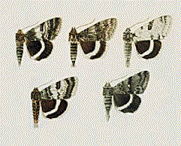Papers in the Biological Sciences
Document Type
Article
Date of this Version
2001
Abstract
The relationship between the perceptual and cognitive abilities of predatory birds and the appearance of their insect prey has long been of intense interest to evolutionary biologists. One classic example is crypsis, the correspondence between the appearance of prey species and of the substrates on which they rest which has long been considered a prime illustration of effects of natural selection, in this case operating against individuals that were more readily detected by predators (Poulton 1890; Wallace 1891). But the influences of predator psychology are broader, more complex, and more subtle than just pattern matching. Many cryptic prey, including the underwing moths (Catocala) that rest against tree bark in the daytime, are also polymorphic. This discontinuous variation in appearance is thought to make prey harder to find initially and harder to detect even after the predator has learned of their appearance (Poulton 1890).
In contrast to cryptic prey, other prey appear to have taken the opposite route, being quite conspicuous in appearance. The aposematic or warning coloration displayed by many distasteful or poisonous species appears to facilitate avoidance learning by predators (Guilford 1990; Schuler & Roper 1992). Batesian mimicry (Bates 1862), in which palatable prey evolve to imitate the appearance of aposematic species, appears to take advantage of the predator's tendency to stimulus generalization (Oaten et al. 1975). Even a century after many of these ideas were first proposed, however, much of the work in this area is still based on correlational data or on experiments that bear only indirectly on the issue.
The reason lies in part in the intractable nature of hypotheses about behavioral evolution. Behavior lacks a substantive fossil record, which means that any account of its origins must necessarily be inferential. Worse, behavioral evolution usually involves a dynamic interplay between the behavior and the environment that is difficult to reconstruct adequately under controlled conditions. As a result, even inferential investigations of the phenomenon generally bear only indirectly on the conditions under which the behavior actually evolved. To circumvent this constraint, we have developed an experimental method that allows realistic, repeatable simulation of the original processes involved in the evolution of color patterns in prey organisms. This "virtual ecology" technique provides an innovative approach to the experimental study of evolutionary dynamics and a quantum improvement in the ability to test evolutionary hypotheses. Our purpose in this chapter is to describe the development of the virtual ecology technique as the product of the cross-fertilization of ideas from a variety of disciplines, including operant psychology, behavioral ecology, population dynamics, and evolutionary computer algorithms. We have chosen to do this in a personal, autobiographical way in an attempt to communicate the flavor of what it has actually been like to experience these developments. In order to be historically accurate, we needed to emphasize the roles of coincidence and happenstance as well as of knowledge and synthesis in this process. We hope that the chapter will be fun to read and that it will provide useful insight into one example of how scientific research actually takes place.



Comments
Published in MODEL SYSTEMS IN BEHAVIORAL ECOLOGY: INTEGRATING CONCEPTUAL, THEORETICAL, AND EMPIRICAL APPROACHES, edited by Lee Alan Dugatkin (Princeton, NJ: Princeton University Press, 2001), pp. 288-310. Copyright 2001 Princeton University Press.